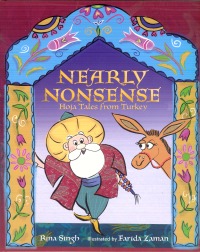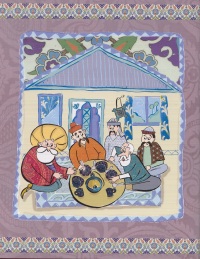| ________________
CM . . . . Volume XVII Number 39. . . .June 10, 2011. 
 |
Nearly Nonsense: Hoja Tales from Turkey.
Rina Singh. Illustrated by Farida Zaman.
Toronto, ON: Tundra Books, 2011.
48 pp., hardcover, $19.99.
ISBN 978-0-88776-974-0.
Subject Headings:
Nasreddin Hoca (Legendary character)-Juvenile literature.
Tales-Turkey-Juvenile literature.
Grades 2-4 / Ages 7-9.
Review by Meredith Ball.
****/4
|
| |
|

excerpt:
Long ago in Turkey, there lived a man named Nasrudin Hoja. He was a mullah, a Muslim teacher, and he had as many lessons to learn as he had to teach.
No matter what the question, Hoja always had an answer. At times, he was caught doing the most foolish things, like trying to catch the moon. But he quickly twisted the situation in such a way that he looked wiser than ever - or at least he tried to.
Nearly Nonsense: Hoja Tales from Turkey is a collection of Turkish folktales, all revolving around the character of Nasrudin Hoja, a Muslim teacher. Each story is silly and, as the title of the collection suggests, rather nonsensical. Among the 10 stories are included the tale of what happened after Hoja was slapped in the face by a stranger, how Hoja dealt with bad customer service at a bathhouse, and what happened when Hoja had nothing to say at his weekly sermon. The character of Hoja is wise and cunning, although it may not always seem so upon first glance. When a wise man asks Hoja how many stars are in the sky, for instance, Hoja states that there are as many stars as there are hairs on his donkey. When the wise man asks him how he can be sure of this, thinking Hoja to be an idiot, Hoja responds by telling the wise man to count the stars and the hairs himself, to see if he is wrong. Beneath the comical happenings of the story, each tale reveals something clever about Hoja, himself, and there is a kernel of universal truth to be gained from every story told.
Rina Singh, who was born in India and immigrated to Canada in the 1980s, has brought this series of Turkish folktales to a North American audience in a way that is clever and entertaining. Although the stories, themselves, originated in Turkey, each tale is universal. On occasion, Turkish words are used in the text, but these words are immediately followed by an English translation, which adds another layer to the story without making it too confusing for readers unaccustomed to the language.
The character of Hoja has long been a part of Turkish folktales, and using a series of stories that follow this classic figure creates a sense of familiarity and appreciation for the character. As readers get glimpses into Hojaís life, they become connected to him, and they see how he manages to turn negative experiences into positive ones, even though justice is always served. The morals of these stories are not directly stated, which also allows this collection to be successful on multiple levels. On the surface, the stories, themselves, are amusing, but, by delving deeper into what Hoja faces and how he deals with the situations at hand, the hidden wisdom that is buried in each tale can be extracted with satisfaction and enjoyment.
 The illustrations, done by Farida Zaman, give the stories a very lighthearted and whimsical feel. The use of patterns in place of solid colours (such as having the sky and bodies of water often represented by bluish flower designs) gives the illustrations a unique style, though the cartoonish way that Hoja and other moving objects are portrayed keeps the images simple and fun. By Zamanís combining this simple cartoon style with the more complex use of patterns in the images, the illustrations work well to accentuate both the simplicities and complexities of the text. The illustrations, done by Farida Zaman, give the stories a very lighthearted and whimsical feel. The use of patterns in place of solid colours (such as having the sky and bodies of water often represented by bluish flower designs) gives the illustrations a unique style, though the cartoonish way that Hoja and other moving objects are portrayed keeps the images simple and fun. By Zamanís combining this simple cartoon style with the more complex use of patterns in the images, the illustrations work well to accentuate both the simplicities and complexities of the text.
Nearly Nonsense: Hoja Tales from Turkey is a delightful collection of stories that are funny and universal, and each tale comes with a piece of wisdom that is worthwhile for everyone to hear.
Highly Recommended.
Meredith Ball is currently completing her Masters of Library and Information Science in London, ON. She loves to read, write, and live in a world of pure imagination.

To comment on this title or this review, send mail to
cm@umanitoba.ca.
Copyright © the Manitoba Library Association. Reproduction for personal use is permitted only if this copyright notice is maintained. Any other reproduction is prohibited without permission.
NEXT REVIEW |
TABLE OF CONTENTS FOR THIS ISSUE- June 10, 2011.
AUTHORS |
TITLES |
MEDIA REVIEWS |
PROFILES |
BACK ISSUES |
SEARCH |
CMARCHIVE |
HOME |

 The illustrations, done by Farida Zaman, give the stories a very lighthearted and whimsical feel. The use of patterns in place of solid colours (such as having the sky and bodies of water often represented by bluish flower designs) gives the illustrations a unique style, though the cartoonish way that Hoja and other moving objects are portrayed keeps the images simple and fun. By Zamanís combining this simple cartoon style with the more complex use of patterns in the images, the illustrations work well to accentuate both the simplicities and complexities of the text.
The illustrations, done by Farida Zaman, give the stories a very lighthearted and whimsical feel. The use of patterns in place of solid colours (such as having the sky and bodies of water often represented by bluish flower designs) gives the illustrations a unique style, though the cartoonish way that Hoja and other moving objects are portrayed keeps the images simple and fun. By Zamanís combining this simple cartoon style with the more complex use of patterns in the images, the illustrations work well to accentuate both the simplicities and complexities of the text.